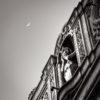One question I have frequently been asked is, “How do you come up with names for your pictures?” For this post I thought I’d put up a few of my abstract photographs along with a quick description of how I came up with the title. If you have ever wondered about a specific image, feel free to leave me a comment on my Facebook page and maybe I’ll put together another post.
1. Tessellation

Tessellation is one of the titles I’ve been asked about most frequently. I think most people who ask just aren’t familiar with the term. Basically, a tessellation is a two-dimensional drawing of a seamless repeating pattern (see below for examples). When I first saw this building with it’s series of cube-like forms and repeating lines, I thought right away of M.C. Escher’s illustrations (example). While my use of the word tessellation as a title for this photograph may not hold up to scrutiny because it is not made up of perfectly repeating shapes, I titled it so anyway because my composition was so strongly inspired by the concept.

After creating and reflecting on the image I had toyed with other Orwellian “big brother” concepts for the title. The featureless, anonymous facade of this structure combined with the strong lines and contrasting tones looks a little intimidating. It reminds me of Russian propaganda poster art. In the end I stuck with Tessellation as the title because I was not trying to send any political message with this piece and, while I’m fine with people interpreting it in that way on their own, it wasn’t part of my inspiration so I wanted to stay true to that in my title.
2. Warp

Warp brings to light a bit of my nerdy side. This building is often lovingly referred to as the “data card building” in Phoenix so I wanted to stay away from the obvious, preexisting metaphor and make my own vision of it. I grew up watching Star Trek with my dad, so, naturally, this building brought to mind images of star trails stretching out before the Starship Enterprise as it entered warp speed.

3. Circumspect

Circumspect is a play on words but it also has a bit of meaning for me, personally. The prefix “circum” is obviously represented in the round windows and semi-circular, concave facade of the architecture. The word circumspect is also a good word to describe aspects of my personality. I am not a big risk-taker in general but I am willing to assume risk when I have carefully considered the situation and determined the potential outcome to be worthy. For example, in order to make this image I might have trespassed a little. This area of the building was surrounded by an 8 foot high fence. I found a gate that was locked. I circled the building again and this time the gate was propped open by a rock while a nurse was taking a smoke break. I entered cautiously, figuring that I would just ask forgiveness if it came down to it. I was born in this building 34 years ago and I really wanted to get the shot I had in mind, so I went for it. A few janitors and nurses on break passed me by while I was shooting and nobody said anything so my trespass couldn’t have been too serious! I’ve been kicked off of more properties while making photographs in Phoenix than I can count. I’m typically a law-abiding citizen that doesn’t go looking for trouble, but when I have a vision in my mind for a photograph there’s a drive that makes me willing to do whatever I have to do to get that image. At least this time I wasn’t called a terrorist (but that’s another story!).
What’s in a name?
Depending on who you talk to, you’ll hear various philosophies about whether a work of art should have a title. One view is that it can give you a deeper insight into the artist’s message or reason for creating that piece, while another view adamantly claims that the imagery should speak for itself (i.e., “a picture is worth a thousand words”) and that the title only taints the viewer’s experience. Then there’s me, floating around somewhere between those two extremes.
I am not typically very creative in naming photographs that deal with literal subject matter because I don’t want to come across as pretentious or trying too hard to inject some esoteric meaning into, for example, a landscape scene. In those cases, naming my photograph is a matter of pragmatism; it needs to have some way of being identified if, for example, someone is contacting me to purchase a print. I wouldn’t care whether or not those images had titles next to them on a gallery wall.
I do, however, particularly enjoy naming my more abstract photographs. For me it is an enjoyable part of the creative process. Since the subject matter is not depicted in a literal way, the title I give it is often descriptive of the metaphor that I saw in my mind’s eye when composing the image. Sometimes my titles offer a play on words to invoke a bit of humor. Sometimes I am more ambiguous, giving a word that would cause the viewer to consider a certain characteristic of the subject, or to pull out a more philosophical exploration of an idea based on that word’s implied connection with the photograph. Sometimes the names are more personal and won’t likely mean the same thing to another viewer at all.
My titles aren’t meant to control the viewer’s interpretation. The fact that I have so many people share alternate interpretations of how they perceive my abstract photographs proves that my titles don’t take away from their viewing experience. It just becomes another conversation between the creator and the viewer, which is fantastic.


